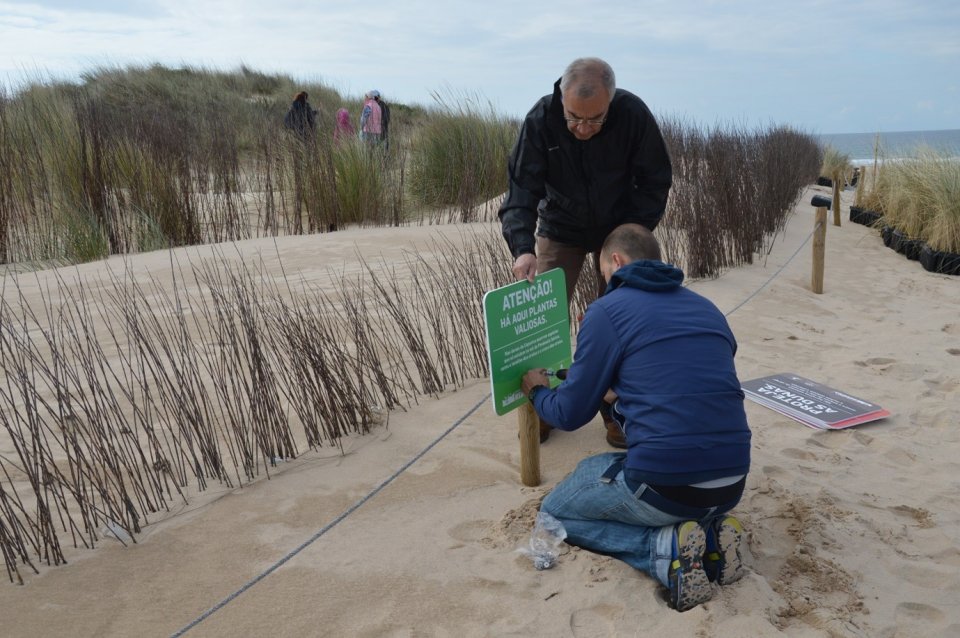
Almada is a coastal county with a 13km long coastline on the Atlantic shore, constituted mostly by sand beaches with dune ecosystems. The bathing area of Costa da Caparica, one of the most sought-after in Portugal by beach-goers, is visited every year by 8 million tourists during the summer months. However, due to rapid sea-level rise, the area’s current coastline regression puts in danger tourist services and the existing private infrastructure, making coastal protection a high priority in this region. The areas of São João da Caparica and Cova do Vapor, adjacent to the Tagus river mouth, are particularly at risk and more susceptible to sea-level rise and severe winter storms, which regularly affect the disadvantaged local communities.
The ReDuna project aims to restore the natural capacity of the Almada sand dune ecosystem to healthily respond to natural drivers, enhancing its resilience to sea level rise and storms, and providing an excellent teaching tool to demonstrate, in a practical way, the benefits of nature-based solutions to both residents and visitors of this beach area.
Education and awareness raising focussed activities and their descriptions
The ReDuna project established strong community involvement from the very beginning, as the project’s design was presented, discussed and defined with engagement of local target groups, who could identify themselves with the project goals and actions from an early stage. The ReDuna project also managed to prove that NbS are useful as complementary actions to artificial beach nourishment, in order to improve ecosystem resilience and provide services as tourism attraction, well-being, nature conservancy and coastal protection. Furthermore, the intervened area of ReDuna has been regularly used as a living lab to showcase the implementation and benefits of NbS in coastal systems, with many guided visits been conducted with groups of interested citizens and school students.
Specific to educational impacts and benefits as a result of NbS Education case study actions
The successful implementation of NbS in projects such as ReDuna makes the benefits of these solutions clearly apparent for anyone visiting the area, thus allowing for it to be used also as an educational tool and adequate demonstrator of best practices in sustainability.
The 12 competencies are part of the GreenComp framework accessible here: https://publications.jrc.ec.europa.eu/repository/handle/JRC128040
Almada NbS Education case specific GreenComp competencies are marked with x below:-
-Embodying sustainability values, including the competences
☒valuing sustainability
☐supporting fairness
☒promoting nature
- Embracing complexity in sustainability, including the competences
☒systems thinking
☐critical thinking
☒problem framing
- Envisioning sustainable futures, including the competences
☒futures literacy
☒adaptability
☐exploratory thinking
- Acting for sustainability, including the competences
☒political agency
☒collective action
☒individual initiative
- Developing climate change adaptation; improving risk management and resilience
- Better protection and restoration of coastal ecosystems
- Increase infiltration / Water storage
- Reduce flood risk
- Carbon sequestration and storage
- Restoring ecosystems and their functions
- Improve connectivity and functionality of green and blue infrastructures
- Increase achievements of biodiversity targets
- Increase Biodiversity
- Increase quality and quantity of green and blue infrastructures
- Increased cultural richness and biodiversity
- Creation of green jobs relating to construction & maintenance of NBS
- Increase awareness of NBS solution & their effectiveness and co benefits
- Increase communities’ sense of ownership
- Increase stakeholder awareness & knowledge about NBS
- Increase well-being
- Increase willingness to invest in NBS
- Social learning about location & importance of NBS
- Sustainable development of coastal regions
Replication potential of the case study (could others use such processes and use the lessons)
Results obtained through continuous monitoring of the project showed that the restored dune promoted resilience to storms and coastal erosion, attesting that it may constitute a reliable solution to be implemented elsewhere in similar contexts. Likewise, the educational and awareness raising potential of such NbS intervened areas among the local communities and visiting population has been amply verified, and is certainly replicable as a demonstration tool of best practices in sustainability.
Generic take-home messages referring to the objective e.g. related to the process of imparting education and awareness: the used process or the methods used.
Goals of NbS projects such as ReDuna must be well aligned with local strategies, which enables significant mind-set changes among policy makers. Success of implemented measures, and well-designed communication, is of paramount importance for acceptance by the general public and users of the area.
1st phase of ReDuna project financed by POVT-12-0233-FCOES-000074 under the EU Cohesion Fund
NBSEduWorld project funded under Horizon Europe
- 4. Quality Education
- 13. Climate Action
- 15. Life On Land
